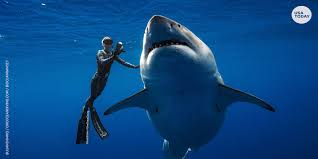The great white shark (Carcharodon carcharias) is one of the most fearsome and fascinating creatures in the ocean. Known for its immense size, powerful hunting skills, and mysterious nature, this apex predator has captured the imagination of marine biologists and ocean lovers alike. Among all the great white sharks ever recorded, a few individuals have stood out due to their extraordinary size. In this article, we will explore the biggest great white shark ever recorded, its habitat, hunting techniques, and why it plays a crucial role in marine ecosystems.
The Biggest Great White Shark Ever Recorded
Deep Blue The Largest Great White Shark
One of the most famous and largest great white sharks ever recorded is Deep Blue. Measuring an astonishing 20 feet (6.1 meters) in length and weighing around 2.5 tons, Deep Blue is an awe-inspiring giant of the ocean. She was first identified off the coast of Guadalupe Island, Mexico, and later spotted near Hawaii. Scientists estimate that Deep Blue is over 50 years old, making her one of the oldest known great white sharks.
Deep Blue gained worldwide recognition when she was filmed in 2013 by marine researcher Mauricio Hoyos Padilla. In 2019, she was seen again near Oahu, Hawaii, feeding on a dead whale. Her size and calm demeanor around divers have made her a legend in the world of marine biology.
Also Read: Shohei Ohtani Wife Everything You Need to Know
Other Massive Great White Sharks
While Deep Blue holds the record for the biggest great white shark, other massive individuals have also been documented:
- The Malta Shark (1987): Allegedly, fishermen caught this shark in the Mediterranean, measuring around 23 feet (7 meters), but its measurements were never officially verified.
- The Cojimar Shark (1945): A fisherman in Cuba reportedly caught a 21-foot (6.4 meters) great white shark, but due to a lack of proper documentation, its exact size remains uncertain.
Where Do the Biggest Great White Sharks Live?
Habitat and Migration Patterns
Great white sharks inhabit oceans worldwide, but the biggest great white sharks commonly appear in specific regions, including:
- Guadalupe Island, Mexico – A hotspot for large great whites, including Deep Blue.
- South Africa – Famous for shark cage diving and great white research.
- Neptune Islands, Australia – Home to some of the world’s largest sharks.
- California, USA – Monterey Bay and the Farallon Islands are key locations for great white sightings.
These sharks migrate thousands of miles between feeding and breeding grounds. Their ability to travel long distances makes tracking them challenging but fascinating for scientists.
How Do Great White Sharks Hunt?
Stealth and Strategy
Great white sharks are apex predators, meaning they have no natural enemies (except humans). They use a combination of speed, intelligence, and stealth to catch their prey. Their hunting strategy includes:
- Ambush Attacks – Sharks often strike from below, launching at their prey with incredible force.
- Serrated Teeth – Their razor-sharp teeth can rip through flesh easily.
- Powerful Jaws – A single bite can exert up to 4,000 psi (pounds per square inch), enough to crush bones.
What Do They Eat?
The diet of a great white shark includes:
- Seals and sea lions
- Fish and rays
- Other sharks
- Dead whales (scavenging)
The largest great white sharks tend to target larger prey, such as elephant seals, which provide them with high amounts of energy.
Why Are Great White Sharks Important?
Ecological Role
Great white sharks play a critical role in maintaining the balance of marine ecosystems. As apex predators, they:
- Control seal and fish populations.
- Prevent the spread of disease by hunting sick or weak prey.
- Maintain healthy ocean biodiversity.
Threats to Their Survival
Despite being at the top of the food chain, great white sharks face several threats:
- Overfishing – Sharks are often caught accidentally in fishing nets.
- Shark Fin Trade – Although illegal in many places, shark finning still happens.
- Climate Change – Warming ocean temperatures impact shark migration and prey availability.
Conservation efforts, such as marine protected areas and stricter fishing regulations, are essential for ensuring the survival of the biggest great white sharks and their smaller counterparts.
FAQs
1. What is the biggest great white shark ever recorded?
The largest confirmed great white shark is Deep Blue, measuring around 20 feet (6.1 meters) long and weighing approximately 2.5 tons.
2. How long do great white sharks live?
Great white sharks can live up to 70 years, making them one of the longest-living shark species.
3. How do scientists track great white sharks?
Scientists use satellite tags, drones, and underwater cameras to track and study great white sharks.
4. Can a great white shark attack a human?
Great white sharks have been involved in shark attacks, but they do not actively hunt humans. Most attacks are accidental, as sharks mistake humans for seals.
5. Are great white sharks endangered?
Great white sharks are classified as vulnerable by the IUCN (International Union for Conservation of Nature). Conservation efforts are in place to protect them from threats like overfishing and habitat destruction.
Final Thoughts
The biggest great white shark remains one of the most awe-inspiring creatures of the deep. Sharks like Deep Blue remind us of the incredible diversity of marine life and the importance of protecting these apex predators. As research continues, we will likely discover even larger great white sharks roaming the oceans. By promoting conservation efforts and respecting their natural habitats, we can ensure that these magnificent creatures continue to thrive in our oceans for generations to come.


